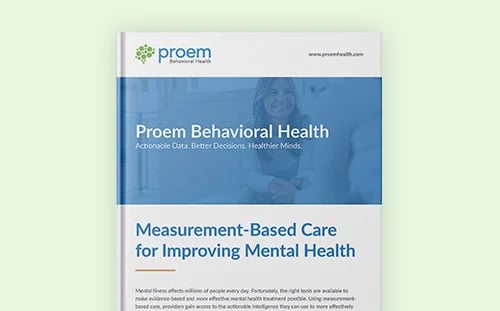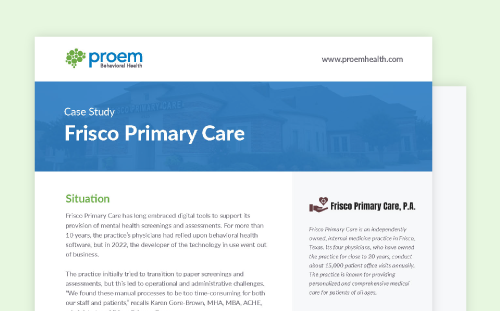According to the U.S. Centers for Disease Control and Prevention (CDC), one in seven Americans experiences a substance use disorder (SUD). However, a pervasive stigma against SUDs still exists, preventing many people from seeking or accepting help.

Healthcare providers have an opportunity to address and reduce this stigma. Every visit with a patient may be an opportunity for an SUD assessment, but providers must create an environment where patients will disclose their needs.
The Primary Care Office as a Safe Space
According to the U.S. Substance Abuse and Mental Health Services Administration (SAMHSA), 41.1 million U.S. adolescents and adults needed substance use services in 2020, but only 4 million received any treatment. Among those who did not receive treatment, nearly all felt no need for treatment and therefore chose not to pursue it. That’s problematic, as untreated SUD can lead to worsening SUD, mental and physical health issues, and other challenges.
A proactive screening process in the primary care office can help to close this SUD treatment gap. Since primary care providers are often the first point of contact between patients and the medical system, it’s vitally important for those offices to be places where patients can discuss their substance use freely.
Building trusting provider-patient relationships
Empathy and an explicit lack of judgment are essential to patient disclosure. In a study of providers in two urban health systems, patients and providers discussed accessing care for substance use disorders. Two of the three barriers were stigma-related: fears of adverse reactions from providers and worries about confidentiality.
Several study participants expressed worry that their providers would blame them for their substance use problems, treating the issue differently than a physical health problem. Patients who enter a healthcare setting with this concern are unlikely to bring up their substance use, so the provider must be proactive.
Creating a judgment-free environment
SUD clinics and providers can establish a safe environment in multiple ways. One option is to offer pamphlets and hang posters addressing the prevalence of substance use disorders, emphasizing the widespread nature of SUD and the possibility of recovery.
It’s also important for clinicians to embrace fault-free language related to substance use issues. Research shows that people, including clinicians, are more likely to blame a “substance abuser” versus a “person with a substance use disorder.” Survey respondents were more confident that someone with a disorder would respond to treatment and were more likely to recommend punishment for an abuser. In other words, the language we use matters.
When conducting an SUD assessment and engaging in casual conversation, providers should default to “disorder” language when referring to problems and emphasize the nature of SUDs as treatable conditions.
 Follow Proem Behavioral Health on LinkedIn to help you stay current with the latest behavioral and mental health news.
Follow Proem Behavioral Health on LinkedIn to help you stay current with the latest behavioral and mental health news.
Educating Clinicians for a Stigma-Free Patient Experience
Research indicates that providers point to a knowledge gap in evaluating and addressing substance use. Without a clear idea of how to assess patients and where to send them in the event of a positive result, providers tend to avoid the topic. In a worst-case scenario, a lack of knowledge can contribute to active stigma against patients with substance use problems.
Substance use stigma among staff
Creating a fault-free SUD approach also requires addressing any stigma among staff. Unfortunately, such stigma is more prevalent than clinicians may wish to accept. For example, in one study, residents regarded patients with alcohol or narcotic dependence more poorly than those with physical complaints.
Providers with internalized stigma may blame the patient for poor care outcomes. In another study, providers with negative attitudes toward SUD suggested that patients’ manipulation efforts, violent tendencies and low motivation were responsible for poor outcomes. Providers with higher levels of stigma also had less experience and training working with this patient group.
Reducing institutional stigma
Education has proven effective at shifting clinicians’ perceptions and ability to provide care. For example, compared to less educated peers, emergency room staff with skills in treating mental disorders feel more hopeful about recovery potential and thus may be more likely to provide attentive treatment.
The same holds true for SUD treatment. All primary care and SUD treatment professionals must receive a thorough grounding in the processes of addiction, the high percentage of people who recover — 75%, according to research — and the effective language to use with recovering individuals.
Integrating Substance Use Treatment and Other Forms of Healthcare
The traditional separation of substance use treatment and medical care speaks to the stigmatization of addiction. Yet, multiple studies have shown that integrating substance use treatment with primary care leads to better outcomes across multiple domains.
Successful integrations connect primary care with behavioral health and SUD clinics, with the patient at the center. This begins with understanding the nature of co-occurring disorders.
How does addiction affect mental health?
Substance use disorders frequently co-occur with mental health conditions such as depression and anxiety. In one 2020 study, 80% of SUD patients reported moderate to high anxiety levels, while 81% experienced moderate to severe depression.
The National Institute of Mental Health (NIMH) recommends concurrent treatment of substance abuse and depression or other mental health issues. Ironically, co-occurring disorders often interfere with a person’s ability to get the help they need due to misdiagnosis and misattribution of SUD symptoms.
To avoid the misdiagnosis trap, SUD clinics and providers must integrate mental health and SUD assessment into their care workflows. By incorporating evidence-based behavioral health tools at the point of care, providers increase the chances of accurate diagnosis and efficient referral for co-occurring conditions like substance abuse and depression. Answering the question, “How does addiction affect mental health?” should be a priority to improve SUD patient outcomes.
Strengthening outcomes with support and care coordination
SUD assessment and treatment must remain part of the overall care continuum, despite the historical separation of substance use treatment. Since substance use is significantly more stigmatized than other mental health issues and physical health issues, its treatment often takes place outside of the broader healthcare model. Yet, integrated care is crucial for reducing stigma and improving outcomes.
Research has shown that patients in a collaborative care model were more than twice as likely to receive treatment for substance use disorders compared to those who received typical siloed care. Also, six months after the initial visit, those in the collaborative care group were significantly less likely to relapse.
Long-term outcomes are also better when patients and their families receive continuing care from provider teams. Involved providers must have training in SUD treatment and access to detailed patient information.
Starting strong with effective and judgment-free screenings
Naturally, continuing care is useful only if the patient has undergone effective treatment. Treatment requires evaluation, which is not always standard in real-world clinical settings.
Some clinics simply do not have a systematic approach to substance use screening, hindering the ability to identify patterns. Unfortunately, screening may also depend on available time, which can be minimal in a busy clinic.
Yet clinicians agree that universal standardized screening is important for health outcomes. To help with that process, they can begin by choosing validated screening tools and sharing information electronically to better ensure continuity of care.
Right Tools, Right Time: How Proem Helps
To improve care access, standardized screenings for substance use and mental health disorders must be a universal part of the clinical workflow. That’s why Proem offers an integrated solution that ties into a provider’s existing continuum of care.
The Proem solution makes it easy for SUD clinics and providers to add routine mental health and SUD assessment to their clinical workflows. The platform offers patient-friendly SUD and behavioral health tools as well as guidance for “next steps” when encountering an SUD diagnosis. Contact Proem today to learn more and schedule a demo.





.png)









